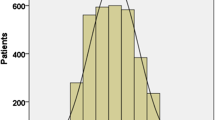Abstract
Introduction
To prevent stroke, anticoagulants should be administered after calculation of CHA2DS2-VASc and HAS-BLED scores in patients with Atrial Fibrillation (AF); nonetheless, these scores are sometimes neglected in clinical settings.
Aim
The present study was designed to assess agreement of anticoagulant therapy according to clinicians and CHA2DS2-VASc and HAS-BLED scores in Iranian AF patients in Moddares Hospital.
Methods
AF patients were diagnosed according to clinical history, clinical examination, and electrocardiogram. Data including the anticoagulant prescription according to clinicians were recorded. CHA2DS2-VASc and HAS-BLED scores were then calculated for each patient. Agreement of anticoagulant therapy according to clinicians and CHA2DS2-VASc and HAS-BLED scores was analyzed using Cohen’s kappa coefficient.
Results
97.5% of the patients (n = 117) were appropriately (according CHA2DS2-VASc and HAS-BLED scores) treated with anticoagulants by clinicians, notwithstanding a 2.5% of patients with inappropriate anticoagulant therapy (n = 3). The Cohen’s kappa coefficient was 0.81 (P = 0.0).
Conclusions
The findings of the present study suggest an almost perfect agreement between anticoagulant therapy according to clinicians and that according to CHA2DS2-VASc and HAS-BLED scores in the studied population.

Similar content being viewed by others
References
Murphy NF, Simpson CR, Jhund PS, Stewart S, Kirkpatrick M, Chalmers J, et al. A national survey of the prevalence, incidence, primary care burden and treatment of atrial fibrillation in Scotland. Heart (British Cardiac Society). 2007;93(5):606–12. doi:10.1136/hrt.2006.107573.
Miyasaka Y, Barnes ME, Gersh BJ, Cha SS, Bailey KR, Abhayaratna WP, et al. Secular trends in incidence of atrial fibrillation in Olmsted County, Minnesota, 1980 to 2000, and implications on the projections for future prevalence. Circulation. 2006;114(2):119–25. doi:10.1161/circulationaha.105.595140.
Watanabe H, Tanabe N, Watanabe T, Darbar D, Roden DM, Sasaki S, et al. Metabolic syndrome and risk of development of atrial fibrillation: the Niigata preventive medicine study. Circulation. 2008;117(10):1255–60. doi:10.1161/circulationaha.107.744466.
Talebi M, Ghertasi M, Taheraghdam A, Andalib S, Sharifipour E. A comparison of risk factors and severity of ischemic stroke in female and male genders in North-West Iran: a cross-sectional study. Iran J Neurol. 2014;13(4):215–9.
Shaafi S, Sharifipour E, Rahmanifar R, Hejazi S, Andalib S, Nikanfar M, et al. Interleukin-6, a reliable prognostic factor for ischemic stroke. Iran J Neurol. 2014;13(2):70–6.
Andalib S, Divani AA, Michel TM, Hoilund-Carlsen PF, Vafaee MS, Gjedde A. Pandora’s box: mitochondrial defects in ischaemic heart disease and stroke. Expert Rev Mol Med. 2017;19:e5. doi:10.1017/erm.2017.5.
Wolf PA, Dawber TR, Thomas HE, Kannel WB. Epidemiologic assessment of chronic atrial fibrillation and risk of stroke the Fiamingham study. Neurology. 1978;28(10):973.
Gage BF, Waterman AD, Shannon W, Boechler M, Rich MW, Radford MJ. Validation of clinical classification schemes for predicting stroke: results from the National Registry of Atrial Fibrillation. JAMA. 2001. doi:10.1001/jama.285.22.2864.
Wolf PA, Abbott RD, Kannel WB. Atrial fibrillation: a major contributor to stroke in the elderly. The Framingham study. Arch Intern Med. 1987;147(9):1561–4.
Wolf PA, Abbott RD, Kannel WB. Atrial fibrillation as an independent risk factor for stroke: the Framingham study. Stroke. 1991. doi:10.1161/01.str.22.8.983.
Lane DA, Lip GY. Use of the CHA(2)DS(2)-VASc and HAS-BLED scores to aid decision making for thromboprophylaxis in nonvalvular atrial fibrillation. Circulation. 2012;126(7):860–5. doi:10.1161/circulationaha.111.060061.
Friberg L, Rosenqvist M, Lip GY. Evaluation of risk stratification schemes for ischaemic stroke and bleeding in 182 678 patients with atrial fibrillation: the Swedish Atrial Fibrillation Cohort study. Eur Heart J. 2012;33(12):1500–10. doi:10.1093/eurheartj/ehr488.
Olesen JB, Torp-Pedersen C, Hansen ML, Lip GY. The value of the CHA2DS2-VASc score for refining stroke risk stratification in patients with atrial fibrillation with a CHADS2 score 0–1: a nationwide cohort study. Thromb Haemost. 2012;107(6):1172–9. doi:10.1160/th12-03-0175.
Gage BF, Yan Y, Milligan PE, Waterman AD, Culverhouse R, Rich MW, et al. Clinical classification schemes for predicting hemorrhage: results from the National Registry of Atrial Fibrillation (NRAF). Am Heart J. 2006;151(3):713–9. doi:10.1016/j.ahj.2005.04.017.
Srivastava A, Hudson M, Hamoud I, Cavalcante J, Pai C, Kaatz S. Examining warfarin underutilization rates in patients with atrial fibrillation: detailed chart review essential to capture contraindications to warfarin therapy. Thromb J. 2008;6(1):6. doi:10.1186/1477-9560-6-6.
Boulanger L, Kim J, Friedman M, Hauch O, Foster T, Menzin J. Patterns of use of antithrombotic therapy and quality of anticoagulation among patients with non-valvular atrial fibrillation in clinical practice. Int J Clin Pract. 2006;60(3):258–64. doi:10.1111/j.1368-5031.2006.00790.x.
Birman-Deych E, Radford MJ, Nilasena DS, Gage BF. Use and effectiveness of warfarin in Medicare beneficiaries with atrial fibrillation. Stroke. 2006;37(4):1070–4. doi:10.1161/01.STR.0000208294.46968.a4.
Cyr L, Francis K. Measures of clinical agreement for nominal and categorical data: the kappa coefficient. Comput Biol Med. 1992;22(4):239–46. doi:10.1016/0010-4825(92)90063-S.
Meiltz A, Zimmermann M, Urban P, Bloch A. Atrial fibrillation management by practice cardiologists: a prospective survey on the adherence to guidelines in the real world. Europace. 2008;10(6):674–80. doi:10.1093/europace/eun086.
Gandolfo C, Balestrino M, Burrone A, Del Sette M, Finocchi C. Stroke due to atrial fibrillation and the attitude to prescribing anticoagulant prevention in Italy. A prospective study of a consecutive stroke population admitted to a comprehensive stroke unit. J Neurol. 2008;255(6):796–802. doi:10.1007/s00415-008-0615-2.
Inoue H, Nozawa T, Hirai T, Iwasa A, Okumura K, Lee J-D, et al. Accumulation of risk factors increases risk of thromboembolic events in patients with nonvalvular atrial fibrillation. Circ J. 2006;70(6):651–6. doi:10.1253/circj.70.651.
Partington SL, Abid S, Teo K, Oczkowski W, O’Donnell MJ. Pre-admission warfarin use in patients with acute ischemic stroke and atrial fibrillation: the appropriate use and barriers to oral anticoagulant therapy. Thromb Res. 2007;120(5):663–9. doi:10.1016/j.thromres.2006.12.019.
Acknowledgements
We thank Shahid Beheshti University of Medical Sciences for its support.
Author information
Authors and Affiliations
Corresponding author
Ethics declarations
Conflict of interest
The authors declare that there is no conflict of interest regarding the present study.
Ethical approval
The present study was approved by local ethics committee.
Informed consent
Written informed consent was obtained from each patient.
Rights and permissions
About this article
Cite this article
Balaghi-Inalou, M., Parsa, S.A., Gachkar, L. et al. Anticoagulant Therapy in Atrial Fibrillation for Stroke Prevention: Assessment of Agreement Between Clinicians’ Decision and CHA2DS2-VASc and HAS-BLED Scores. High Blood Press Cardiovasc Prev 25, 61–64 (2018). https://doi.org/10.1007/s40292-017-0237-9
Received:
Accepted:
Published:
Issue Date:
DOI: https://doi.org/10.1007/s40292-017-0237-9




